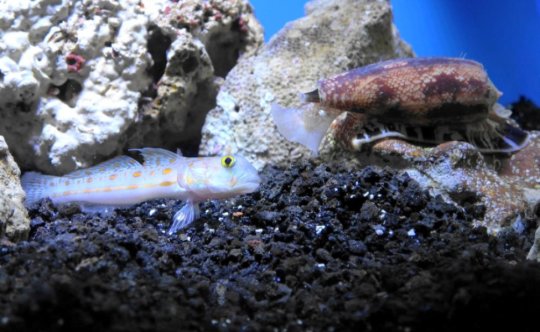[ad_1]
Although moderately mobile, marine cone snails have perfected several strategies to capture prey. Some fish-hunting species release venom into the surrounding water. Within the plume of toxic venom, the fish succumbs to fast-acting insulin that renders it immobile. As the fish flounders, the snail emerges from its shell to swallow the pacified victim whole.
Researchers at University of Utah Health detailed the function of cone snail insulins, bringing them one step closer to developing a faster-acting insulin to treat diabetes. The results of the study are available in the February 12 issue of the journal eLife.
“These snails have developed a strategy to hit and subdue their prey with up to 200 different compounds, one of which is insulin,” said Helena Safavi-Hemami, Ph.D., assistant professor of Biochemistry at U of U Health and senior author on the paper. “Every now and then, we learn something unique from nature and millions of years of evolution.”
Insulin, a hormone produced by the pancreas to regulate blood sugar, consists of two segments called A and B chains. The B cluster forms dimers and hexamers that allow the pancreas to store the hormone for later use. This segment is also necessary to activate the insulin receptors that signal the body to take up sugar from the blood. Insulin must undergo several conversions to decluster before it can lower blood sugar.
A person with type 1 diabetes is unable to produce insulin and requires daily injections to manage their blood sugar. Despite decades of research, the manufactured insulin continues to contain the B chain in order to activate the receptor to lower blood sugar, delaying the drug’s effect by 3090 minutes.
Safavi-Hemami and her team examined the function of seven insulin sequences found in the venom from three species of cone snail Conus geographus, C. tulipa and C. kinoshitai. Unexpectedly, each species produces insulin with slightly different structures. Despite these differences, each insulin is fast-acting because it lacks the sticky part of the B chain found in human insulin.
“Evolution may be the driving force to increase the molecular diversity of the toxin molecules that the cone snail species use for hunting prey,” said Danny Hung-Chieh Chou, Ph.D., assistant professor of Biochemistry at U of U Health and a co-author on the paper.
The team tested how each of the insulin sequences lowered blood sugar in zebrafish and mice. The model animals were treated with streptozotocin to induce symptoms of type 1 diabetes before the animals were dosed with the different synthesized insulins.
Safavi-Hemami found three of the venom-generated insulin sequences (Con-Ins T1A from C. tulipa, Con-Ins G1 from C. geographus and Con-Ins K1 from C. kinoshitai) lowered blood sugar effectively. Using cell lines, they found the cone snail insulin sequences were able to bind to and activate the human insulin receptor, despite missing the part of the B chain found in human insulin. These sequences, however, are 10 to 20 times less potent than human insulin.
According to Safavi-Hemami, each unique configuration provides the research team a slightly different template to consider when designing new drugs that act quickly and effectively.
“We are beginning to uncover the secrets of cone snails,” said Safavi-Hemami. “We hope to use what we learn to find new approaches to treat diabetes.”
Story Source:
Materials provided by University of Utah Health. Note: Content may be edited for style and length.
[ad_2]















